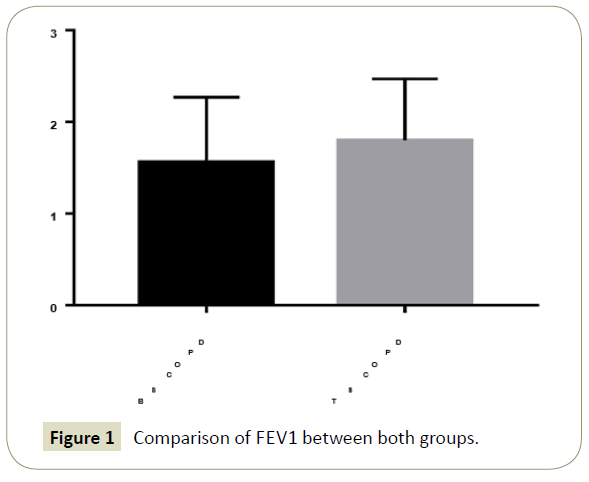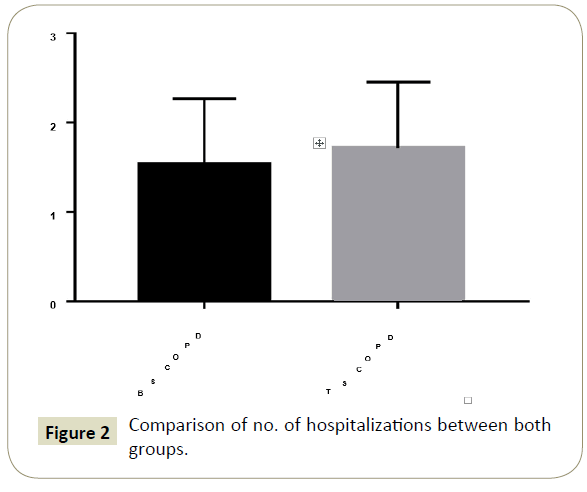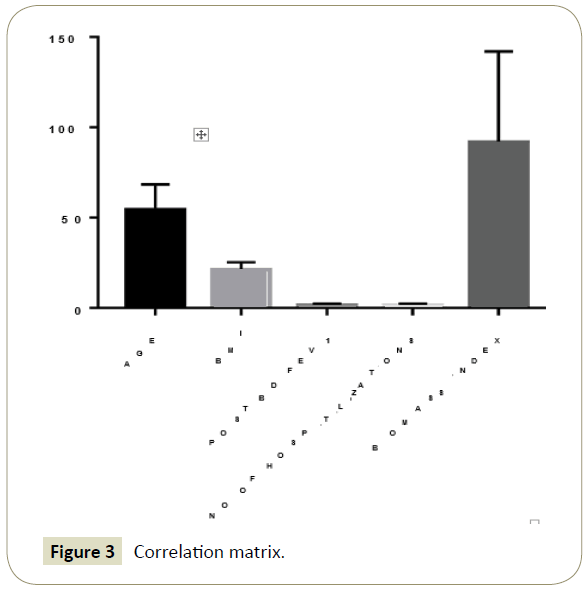Evaluation of Biomass Exposure-Associated Chronic Obstructive Pulmonary Disease at a Tertiary Care Hospital
Rao K, Vamshi K, Bhaskar L, Surendar Reddy K and Waghray P
Rao K, Vamshi K, Bhaskar L, Surendar Reddy K* and Waghray P
Department of Pulmonary Medicine, SVS Medical College & Hospital, Mahbubnagar, Telangana
- *Corresponding Author:
- Surendar Reddy K
Department of Pulmonary Medicine
SVS Medical College & Hoapital
Mahbubnagar, Telangana, India
Tel: 9949316154
E-mail: surendark918@gmail.com
Received Date: January 31, 2018; Accepted Date: February 15, 2018; Published Date: February 27, 2018
Citation: Rao K, Vamshi K, Bhaskar L, Reddy KS, Waghray P (2018) Evaluation of Biomass Exposure-Associated Chronic Obstructive Pulmonary Disease at a Tertiary Care Hospital. Insights Chest Dis 3:2.
Abstract
Context: Exposure to smoke from biomass fuel has been established as a causative factor of irreversible airway obstruction in recent GOLD update. India harbouring a vast majority of rural population may have significant population suffering from airway obstruction due to biomass exposure. Research on similarities and differences in airway disease produced by exposure to biomass fuel smoke while cooking vs. smoking tobacco may provide new insights on such entity. The study aims to evaluate women population presenting with COPD symptoms and their spirometry similarities with smoking related COPD.
Settings and design: It was a prospective study conducted in a tertiary care hospital.
Subjects and methods: Stable COPD patients presenting to chest OPD were taken as study group. Equal number of healthy controls were enrolled. COPD patients were subjected to detailed clinical evaluation and lung function test. History of biomass exposure was evaluated from both groups through self-reporting. Biomass related COPD patients were identified, and their prevalence and distinguishing features evaluated.
Results: Of 85 COPD patients, 43 (50.6%) had history of exposure to biomass. Patients with biomass-associated COPD were invariably females while others were males. The airflow limitation was similar in both groups.
Conclusion: BS-COPD constitutes a significant proportion of overall COPD prevalence. In view of its preponderance among females, biomass alternatives must be provided to rural population which can significantly reduce the burden of disease.
Keywords
COPD; Tuberculosis; Apnoea; Myocardial infarction; Lung volumes
Introduction
Solid fuel burning viz. dung, wood, agricultural residues and coal is still prevalent as a means for cooking in most parts of world [1,2]. Under-developed countries and rural areas account for most of such biomass fuel use. The pollution level due to such use is often found to be much higher than accepted safe levels especially in indoor areas. Tobacco smoke and biomass smoke has a variety of pollutant resemblance with both forms of smoke being carcinogenic [1,3-6]. In countries like India, people from poor families and rural areas tend to use biomass for cooking and heating purpose due to unavailability of safer means. Such use of biomass has been associated with adverse impact on health of such individuals [7-12].
3.2 million deaths, and 111 million disability-adjusted life-years (DALYs) were reported in 2010 due to solid fuel use worldwide [13].
Women in rural areas are predominantly affected because of long exposure to biomass smoke while cooking. This associated with closed indoors without proper ventilation makes them prone for developing chronic obstructive pulmonary disease (COPD) associated with biomass smoke inhalation.
Subjects and Methods
It was a prospective study conducted in a tertiary care hospital over a period of 6 months (April 2017 to September 2017). Eighty-five consecutive patients of stable COPD attending chest OPD were enrolled as cases. An equal number of healthy subjects with similar age and gender distribution were taken as controls. Informed consent was taken from all subjects. COPD patients with other pulmonary comorbidities such as obstructive sleep apnoea, interstitial lung disease, lung cancer, congestive heart failure, unstable angina, recent myocardial infarction, and acute exacerbation of COPD in the past 4 weeks were excluded from the study. The study was approved by the Institutional Ethics Committee. Detailed clinical history and medical examination were done with an emphasis on number of previous exacerbations, previous hospitalizations, tobacco smoke exposure, and occupational exposures to dust and smoke. Routine spirometry was performed as per the recent ATS guidelines using SPIROLAB 6000 PC-based Spirometer. Post-bronchodilator forced expiratory volume in 1 s (FEV1), forced vital capacity (FVC), and FEV1/FVC values were recorded based on which patients were categorized into four stages of airflow limitation as per recent GOLD guidelines (Figure 1). In addition, FEF25-75 was also recorded to check for small airway disease (Table 1).
| COPD (N=42) | Biomass (N=43) | P-Value | |
|---|---|---|---|
| Age Mean ± SD | 58.38 ± 11.15 | 54.14 ± 14.24 | 0.1307 |
| BMI | 20.45 ± 4.44 | 21.20 ± 4.07 | 0.4179 |
| Cough | 28.57% | 69.76% | 0.0002 |
| Dyspnoea grades (MMRC) | 0.9208 | ||
| GRADE 1 | 7 | 20 | |
| GRADE 2 | 16 | 17 | |
| GRADE 3 | 10 | 5 | |
| GRADE 4 | 9 | 2 | |
| POST BD FEV1 | 1.797 ± 0.670 | 1.558 ± 0.710 | 0.1143 |
| POST BD FVC | 2.761 ± 0.953 | 2.724 ± 1.231 | 0.8767 |
| POST BD FEF 25-75 | 2.288 ± 1.061 | 2.226 ± 1.114 | 0.7941 |
| COPD grades | |||
| MILD | 12 | 16 | 0.8946 |
| MODERATE | 18 | 13 | |
| SEVERE | 6 | 9 | |
| VERY SEVERE | 6 | 6 | |
| No. of hospitalizations | 1.714 ± 0.742 | 1.535 ± 0.735 | 0.2661 |
Table 1: Comparison of features between biomass-associated chronic obstructive pulmonary diseases with other chronic obstructive pulmonary disease.
Patients were labelled as BS-associated COPD only if exposure to biomass is present and no other confounding factors such as TB, Smoking, other airway diseases are existing. Biomass index defined as number of hours of biomass smoke exposure per day multiplied by number of years of exposure was calculated in these patients.
The prevalence of BS-associated COPD and clinical characteristics were evaluated, and its different parameters were compared with TS-COPD patients (Table 2).
| FEV1 | Biomass index | |||
|---|---|---|---|---|
| Parameter | Pearson coefficient |
P-Value | Pearson coefficient |
P-Value |
| Age | -0.3523 | 0.0205 | 0.6077 | 0.0001 |
| BMI | 0.1896 | 0.2234 | -0.08707 | 0.5788 |
| No of hospitalizations | -0.7448 | 0.0001 | 0.2283 | 0.1408 |
| Biomass index | -O.4394 | 0.0032 | 1 | - |
| FEV1 | 1 | - | -0.439 | 0.003 |
Table 2: Correlation of forced expiratory volume in 1s and no of previous hospitalizations with different parameters in BIOMASS-associated chronic obstructive pulmonary disease.
Statistical Analysis
Data was analysed by GraphPad Prism 7.01 version. Data was summarized by Mean ± SD for continuous data, and percentages for categorical data. The comparison between two groups was done by Unpaired t-test/Mann Whitney U test for continuous data. The association between variables was done by Chi-Square test/Fisher exact test/Proportion test for categorical data. All P-values less than 0.05 were considered statistically significant.
Results
A total of 85 patients were enrolled for the study. 43 were females and 42 were males. BS-COPD was found exclusively in females while TS-COPD in males. Mean biomass index was 89 among BS-COPD patients.
Comparison between tuberculosis-associated chronic obstructive pulmonary disease and other chronic obstructive pulmonary disease
BS-COPD patients were exclusively females while TS-COPD were males. The reason being women are more involved in domestic tasks especially cooking and prolonged working hours in kitchen causing them more exposure to biomass smoke. TS-COPD patients had predominant symptom of dyspnoea while in contrast BS-COPD patients complained of cough. (p=0.0002). There wasn’t much statistical difference in spirometry parameters among both the groups (Table 1). In BS-associated COPD patients, on univariate analysis, BIOMASS INDEX showed positive correlation with age, and no. of hospitalizations (Figures 2 and 3). Fev1 showed positive correlation with age. These signify that as biomass index increases quality of life detoriates as evident by BMI, no. of hospitalizations and FEV1 values.
Discussion
There isn’t much documentation regarding the difference in pathogenicity between damage caused by tobacco smoke and biomass smoke [14,15]. The studies conducted revealed similar oxidative stress on exposure to tobacco smoke and biomass smoke in animal models [15-18].
Individuals with BSCOPD have elevated levels of malonaldehyde and superoxide dismutase in comparison to healthy population. This has an inverse correlation with FEV115. Increased elastolysis activity of macrophages14 and of serum C-reactive protein19 is found in both TS-COPD AND BS-COPD [19-21].
Ramirez-Venegas et al. conducted a study on both the entities and found many similarities and important differences. In contrast to their study, which asserted that airflow obstruction was less severe in BS-COPD than TS-COPD, we found that it was of same degree [22].
Padmavati et al. identified co-pulmonale and pulmonary artery hypertension as important complication of biomass exposure. Mild to moderate PAH was found in many patients in their study. Abnormalities of small pulmonary arterioles with intimal thickening was concluded as possible hypothesis in causing PAH in these patients [23].
Jordi Olloquequi et al. compared TS-COPD, BS-COPD and patients with exposure to both the factors. They found physiological and inflammatory differences between both groups. BS-COPD group had elevated IgE levels in blood suggesting a role for Th2 response in the pathogenesis [24].
Many other studies conducted on biomass revealed its status as an important risk factor in causing COPD. Lin-ling Cheng et al. evaluated clinical characteristics, co-morbidities and exacerbation risk in both groups and concluded there was no statistically significant difference in between these groups. In keeping with this study, we found similar grades of airway obstruction though we didn’t evaluate other parameters mentioned.
Some limitations of this study must be mentioned. Due to many exclusion criterion, the study sample size was small and so variation in results was limited. Evaluation of lung volumes, inflammatory mediators, co-morbidities would have clearly demarcated the differences between both groups, but we felt that limited resources and small sample size, would hamper the result [25].
Conclusion
BS-COPD may constitute significant proportion of overall COPD prevalence and is neglected often. Using cleaner energy for cooking and avoiding biomass fuel burning significantly improves the quality of life in rural women. Larger observational and epidemiological studies are need of hour to establish it as a risk factor for COPD and thereby educating people towards need of clean energy.
References
- Naeher LP, Brauer M, Lipsett M, Zelikoff JT, Simpson C, et al. (2007) Woodsmoke health effects: A review. Inhal Toxicol 19: 67-106.
- Bruce N, Rehfuess E, Mehta S, Hutton G, Smith K (2006) Indoor air pollution. In: Jamison D, Breman J, Measham A (eds) Disease control priorities in developing countries. 2nd edn. Washington: Oxford University Press and The World Bank 793-815.
- Balmes JR (2010) When smoke gets in your lungs. Proc Am Thorac Soc 7 :98-101.
- Smith KR (1987) Biofuels, air pollution and health. 1st edn. New York: Plenum Press.
- Spengler JD, Samet J (1991) A perspective on indoor and outdoor air pollution. In: Samet J, Spengler JD (eds) Indoor Air Pollution: A Health Perspective. Baltimore: The Johns Hopkins University Press 1-29.
- Owusu Boadi K, Kuitunen M (2006) Factors affecting the choice of cooking fuel, cooking place and respiratory health in the Accra metropolitan area, Ghana. J Biosoc Sci 38: 403-412.
- Smith K, Mehta S, Maeusezahl-Feuz M (2004) Indoor air pollution from household use of solid fuels: Comparative quantification of health risks. In: Ezzati M, Lopez A, Rodgers A, Murray C (eds) Global and Regional Burden of Disease Attributable to Selected Major Risk Factors. Geneva: World Health Organization 1435-1493.
- Kurmi OP, Semple S, Simkhada P, Smith WC, Ayres JG (2010) COPD and chronic bronchitis risk of indoor air pollution from solid fuel: A systematic review and meta-analysis. Thorax 65: 221-228.
- Po JY, FitzGerald JM, Carlsten C (2011) Respiratory disease associated with solid biomass fuel exposure in rural women and children: Systematic review and meta-analysis. Thorax 66: 232-239.
- Hu G, Zhou Y, Tian J, Yao W, Li J, et al. (2010) Risk of COPD from exposure to biomass smoke: A metaanalysis. Chest 138: 20-31.
- Torres-Duque C, Maldonado D, Perez-Padilla R, Ezzati M, Viegi G (2008) Biomass fuels and respiratory diseases: A review of the evidence. Proc Am Thorac Soc 5: 577-590.
- Bruce N, Perez-Padilla R, Albalak R (2000) Indoor air pollution in developing countries: A major environmental and public health challenge. Bull World Health Organ 78: 1078-1092.
- Lim SS, Vos T, Flaxman AD, Danaei G, Shibuya K, et al. (2012) A comparative risk assessment of burden of disease and injury attributable to 67 risk factors and risk factor clusters in 21 regions, 1990-2010: A systematic analysis for the Global Burden of Disease Study 2010. Lancet 380: 2224-2260.
- Montano M, Beccerril C, Ruiz V, Ramos C, Sansores RH, et al. (2004) Matrix metalloproteinases activity in COPD associated with wood smoke. Chest 125: 466-472.
- Montano M, Cisneros J, Ramirez-Venegas A, Chaverri JP, Mercado D, et al. (2010) Malondialdehyde and superoxide dismutase correlate with FEV1 in patients with COPD associated with wood smoke exposure and tobacco smoking. Inhal Toxicol 22: 868-874.
- Sussan TE, Ingole V, Kim JH, Cormick S, Negherbon J, et al. (2014) Source of biomass cooking fuel determines pulmonary response to household air pollution. Am J Resp Cell Mol Biol 50: 538-548.
- Mehra D, Geraghty PM, Hardigan AA, Foronjy R (2012) A comparison of the inflammatory and proteolytic effects of dung biomass and cigarette smoke exposure in the lung. PloS One 7: e52889.
- Lal K, Dutta KK, Vachhrajani KD, Gupta GS, Srivastava AK (1993) Histomorphological changes in lung of rats following exposure to wood smoke. Indian J Exp Biol 31: 761-764.
- Liu PL, Chen YL, Chen YH, Lin SJ, Kou YR (2005) Wood smoke extract induces oxidative stress-mediated caspase-independent apoptosis in human lung endothelial cells: role of AIF and EndoG. Am J Physiol 289: L739-749.
- Ramos C, Pedraza-Chaverri J, Becerril C, Cisneros G, Avila G, et al. (2013) Oxidative stress and lung injury induced by short-term exposure to wood smoke in guinea pigs. Toxicol Mech Methods 23: 711-722.
- Aksu F, Capan N, Aksu K, Ofluoglu R, Canbakan S, et al. (2013) C-reactive protein levels are raised in stable Chronic obstructive pulmonary disease patients independent of smoking behavior and biomass exposure. J of Thorac Dis 5: 414-421.
- Ramirez-Venegas A, Sansores RH, Perez-Padilla R, Regalado J, Velazquez A, et al. (2006) Survival of patients with chronic obstructive pulmonary disease due to biomass smoke and tobacco. Am J Respir Crit Care Med 173: 393-397.
- Padmavati S, Pathak SN (1959) Chronic Cor Pulmonale in Delhi. Circulation 20:343-352.
- Olloquequi J, Jaime S, Parra V, Cornejo-Córdova E, Valdivia G, et al. (2018) Comparative analysis of COPD associated with tobacco smoking, biomass smoke exposure or both. Respiratory Research 19: 13.
- Cheng LL, Liu YY, Su ZY, Liu J, Chen RC, et al. (2015) Clinical characteristics of tobacco smoke-induced versus biomass fuel induced chronic obstructive pulmonary disease. J Transl Int Med 3: 126-129.
Open Access Journals
- Aquaculture & Veterinary Science
- Chemistry & Chemical Sciences
- Clinical Sciences
- Engineering
- General Science
- Genetics & Molecular Biology
- Health Care & Nursing
- Immunology & Microbiology
- Materials Science
- Mathematics & Physics
- Medical Sciences
- Neurology & Psychiatry
- Oncology & Cancer Science
- Pharmaceutical Sciences



